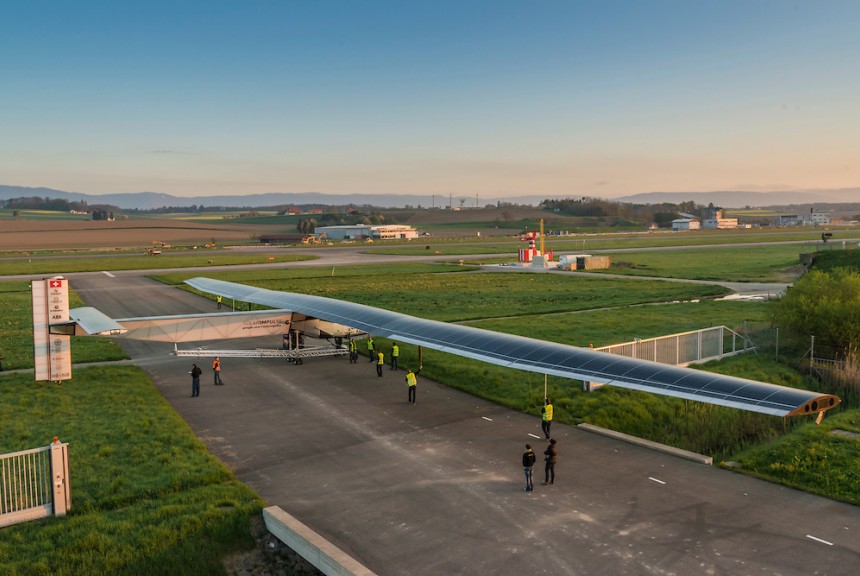Curtain is up for a visionary project, the decisive second Solar Impulse aircraft has now been completed. The plane, which is to be the first to travel around the world entirely without fuel in 2015, is unveiled on April 19, 2014 in Payerne, Switzerland. On board are numerous innovative products and solutions that make the plane especially lightweight and energy efficient. On its historic journey around the world, the plane is to be powered solely by the sun. The energy will be generated by roughly 17,200 solar cells on the wings, which at 72 meters have a span equal to that of the largest passenger airliners. The entire aircraft however weighs only 2.3 tons.
Day and night without fuel
The new plane is the advancement of a first prototype, which demonstrated in 2010 the feasibility to fly day and night only on solar energy and since then successfully completed numerous flights, most recently a coast-to-coast journey across the United States. The second model will undertake a number of test flights this year as well, prior to setting off on its big mission in March 2015.
The aircraft was unveiled to a large audience invited by Bertrand Piccard and André Borschberg, who founded the Solar Impulse project over ten years ago. The two Swiss pioneers want their project to demonstrate the tremendous potential of existing technologies for contributing to energy efficiency, renewable energies and new transportation solutions.
“The Solar Impulse initiative is both scientific and innovative. It is also philosophical, by its goal of raising awareness in society about the need to save our planet’s energy resources. Without Bayer and its mission of conducting ‘Science For A Better Life’ this solar airplane would never have been light and efficient enough to be able to fly night and day without fuel,” Piccard said.
Lightness and Robustness
Group of the engineers led by André Borschberg, who managed to build the entire structure proportionately 10 times lighter than that of the best glider. Every gram added had to be deducted somewhere else, to make room for enough batteries on board, and provide a cockpit in which a pilot can live for a week. In the end, it is of the weight of a small van of 2300kg, stimulating innovation in the field of sheets of carbon, which now weigh only a third as much as sheets of printer paper (25 g/m2). The airframe is made of composite materials i.e carbon fibre with honeycomb sandwich structure.
The upper wing surface is covered by a skin consisting of encapsulated solar cells, and the lower surface by a high-strength, flexible skin. 140 carbon-fiber ribs spaced at 50 cm intervals give the wing its aerodynamic cross-section, and also maintain its rigidity. Solar Impulse can fly at the same speed than a car, between 36 km/h (20 Kts) and 140 km/h (77 Kts). At sea level with a minimum speed of 36 km/h (20 Kts) and maximum speed of 90 km/h (49 Kts) and at maximum altitude, from 57 km/h (31,5 Kts) to 140 km/h (77 Kts).
Highly efficient insulation
Bayer contributed a lot of technical expertise to the project. Among other things it was responsible for the complete design of the cockpit shell. One material the company is providing for this purpose is the extremely high-performance insulating material Baytherm® Microcell. Its insulating performance is as much as 10 percent greater than the current standard. Highly efficient insulation is particularly important for the aircraft because it must withstand temperature fluctuations between minus 40 degrees Celsius at night and plus 40 degrees during the day.
Baytherm® Microcell is used for the aircraft door, while the rest of the cockpit shell is made of a different type of rigid polyurethane foam from Bayer MaterialScience. The company also supplies a polyurethane/carbon fiber composite material for the door locks, and thin sheets of transparent, high-performance polycarbonate for the window. Although the cockpit is larger overall than in the first prototype, it is only minimally heavier.
Solar Impulse wants to motivate people to use clean technologies. This illustrates how realistic the message of Solar Impulse is. The project will help understand for everyone to use electrical power as efficiently as on our solar airplane, and to enable renewable energy and sustainable transport.



